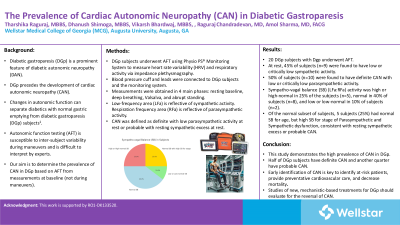Monday Poster Session
Category: Functional Bowel Disease
P2350 - The Prevalence of Cardiac Autonomic Neuropathy (CAN) in Diabetic Gastroparesis
Monday, October 28, 2024
10:30 AM - 4:00 PM ET
Location: Exhibit Hall E

Has Audio

Tharshika Raguraj, MD
Augusta University
Grovetown, GA
Presenting Author(s)
Tharshika Raguraj, MD1, Dhanush Shimoga, MBBS2, Vikarsh Bhardwaj, MBBS3, Raguraj Chandradevan, MBBS2, Amol Sharma, MS, MD, FACG2
1Augusta University, Augusta, GA; 2Medical College of Georgia at Augusta University, Augusta, GA; 3Jawaharlal Nehru Medical College, New Dehli, Delhi, India
Introduction: Diabetic gastroparesis is a prominent feature of diabetic autonomic neuropathy (DAN) and precedes the development of cardiac autonomic neuropathy (CAN). Changes in autonomic function described by the NIDDK Gastroparesis Consortium can separate diabetics with normal gastric emptying from diabetic gastroparesis (DGp) subjects. Autonomic function testing (AFT) is questionable in its correlation to GI autonomic dysfunction, is associated with inter-subject variability during maneuvers, and is difficult to interpret by experts. Our objective is to determine the prevalence of CAN in diabetic gastroparesis based on AFT from measurements at resting baseline.
Methods: DGp subjects underwent AFT using Physio PS® Monitoring System to measure heart rate variability and respiratory activity via impedance plethysmography. Blood pressure cuff and leads were connected to DGp subjects and the monitoring system. Measurements were obtained in 4 main phases: resting baseline, deep breathing, Valsalva, and abrupt standing. Low-frequency area (LFa) is reflective of sympathetic activity. Respiration frequency area (RFa) is reflective of parasympathetic activity. CAN was defined as definite with low parasympathetic activity at rest or probable with resting sympathetic excess at rest.
Results: 20 DGp subjects with diabetic gastroparesis underwent AFT. At rest, 45% of subjects (n=9) were found to have low or critically low sympathetic activity. 50% of subjects (n=10) were found to have definite CAN with low or critically low parasympathetic activity. Sympatho-vagal balance (SB) (LFa:RFa) activity was high or high-normal in 25% of the subjects (n=5), normal in 40% of subjects (n=8), and low or low-normal in 10% of subjects (n=2). Of the normal subset of subjects, 5 subjects (25%) had normal SB for age, but high SB for stage of Parasympathetic and Sympathetic dysfunction, consistent with resting sympathetic excess or probable CAN.
Discussion: CAN is associated with a high risk of sudden cardiac death. This study demonstrates the high prevalence of CAN in DGp. Half of DGp subjects have definite CAN and another quarter have probable CAN. Early identification of CAN is key to reverse autonomic dysfunction and decrease mortality.
Disclosures:
Tharshika Raguraj, MD1, Dhanush Shimoga, MBBS2, Vikarsh Bhardwaj, MBBS3, Raguraj Chandradevan, MBBS2, Amol Sharma, MS, MD, FACG2. P2350 - The Prevalence of Cardiac Autonomic Neuropathy (CAN) in Diabetic Gastroparesis, ACG 2024 Annual Scientific Meeting Abstracts. Philadelphia, PA: American College of Gastroenterology.
1Augusta University, Augusta, GA; 2Medical College of Georgia at Augusta University, Augusta, GA; 3Jawaharlal Nehru Medical College, New Dehli, Delhi, India
Introduction: Diabetic gastroparesis is a prominent feature of diabetic autonomic neuropathy (DAN) and precedes the development of cardiac autonomic neuropathy (CAN). Changes in autonomic function described by the NIDDK Gastroparesis Consortium can separate diabetics with normal gastric emptying from diabetic gastroparesis (DGp) subjects. Autonomic function testing (AFT) is questionable in its correlation to GI autonomic dysfunction, is associated with inter-subject variability during maneuvers, and is difficult to interpret by experts. Our objective is to determine the prevalence of CAN in diabetic gastroparesis based on AFT from measurements at resting baseline.
Methods: DGp subjects underwent AFT using Physio PS® Monitoring System to measure heart rate variability and respiratory activity via impedance plethysmography. Blood pressure cuff and leads were connected to DGp subjects and the monitoring system. Measurements were obtained in 4 main phases: resting baseline, deep breathing, Valsalva, and abrupt standing. Low-frequency area (LFa) is reflective of sympathetic activity. Respiration frequency area (RFa) is reflective of parasympathetic activity. CAN was defined as definite with low parasympathetic activity at rest or probable with resting sympathetic excess at rest.
Results: 20 DGp subjects with diabetic gastroparesis underwent AFT. At rest, 45% of subjects (n=9) were found to have low or critically low sympathetic activity. 50% of subjects (n=10) were found to have definite CAN with low or critically low parasympathetic activity. Sympatho-vagal balance (SB) (LFa:RFa) activity was high or high-normal in 25% of the subjects (n=5), normal in 40% of subjects (n=8), and low or low-normal in 10% of subjects (n=2). Of the normal subset of subjects, 5 subjects (25%) had normal SB for age, but high SB for stage of Parasympathetic and Sympathetic dysfunction, consistent with resting sympathetic excess or probable CAN.
Discussion: CAN is associated with a high risk of sudden cardiac death. This study demonstrates the high prevalence of CAN in DGp. Half of DGp subjects have definite CAN and another quarter have probable CAN. Early identification of CAN is key to reverse autonomic dysfunction and decrease mortality.
Disclosures:
Tharshika Raguraj indicated no relevant financial relationships.
Dhanush Shimoga indicated no relevant financial relationships.
Vikarsh Bhardwaj indicated no relevant financial relationships.
Raguraj Chandradevan indicated no relevant financial relationships.
Amol Sharma indicated no relevant financial relationships.
Tharshika Raguraj, MD1, Dhanush Shimoga, MBBS2, Vikarsh Bhardwaj, MBBS3, Raguraj Chandradevan, MBBS2, Amol Sharma, MS, MD, FACG2. P2350 - The Prevalence of Cardiac Autonomic Neuropathy (CAN) in Diabetic Gastroparesis, ACG 2024 Annual Scientific Meeting Abstracts. Philadelphia, PA: American College of Gastroenterology.
